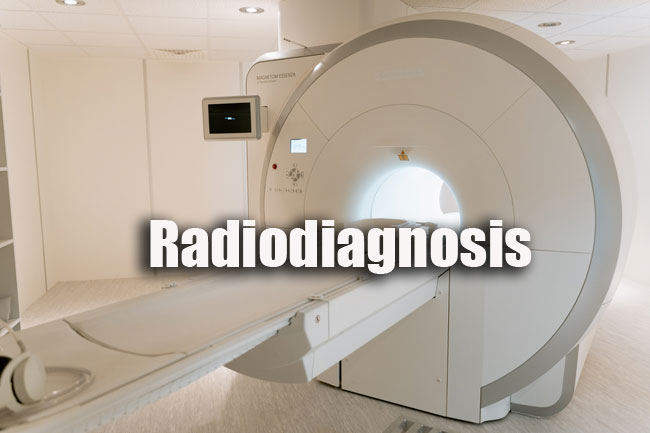Radiodiagnosis Practice Set
Radiodiagnosis Practice Set paper for the written examination is given below. Candidates who are looking for Radiodiagnosis exam Practice Set paper can find in this section. The applied candidates who are getting prepared for the Radiodiagnosis can view this page for the Radiodiagnosis Last Ten Years Practice Set Papers.

Download the Radiodiagnosis Practice Set & Solutions & make it as a reference for your exam preparation. Take advantage of these Radiodiagnosis Practice Set Papers in a proper manner to get qualifying Marks. Last 5 years Radiodiagnosis Practice Set Papers provided here. Candidates who are applied for the above exam can check and download the Radiodiagnosis Practice Set Papers from here.
Practice Set of Radiodiagnosis
1. HRCT in a 44-year-old woman with history of increasing shortness of breath reveal, mediastinal lymphadenopathy, well-defined nodular opacities found subpleurally and along the broncho vascular bundles. There is a predominantly mid to upper zone distribution with some air trapping demonstrated. Which one of the following is the most likely diagnosis ?
(1) Acute extrinsic allergic alveolitis
(2) Langerhans cell histiocytosis
(3) Lymphangioleiomyomatosis
(4) Sarcoidosis
2. Which of the following feature would make a diagnosis of Extrinsic allergic alveolitis (EAI) more likely than Respiratory bronchiolitis interstitial lung disease (RB-ILD) ?
(1) A normal chest radiograph
(2) A positive smoking history
(3) Exposure to paint sprays
(4) Poorly defined centrilobular nodules
3. A 30-year-old patient has presented with a non-productive cough, fatigue, weight loss and a fever. As a result of an abnormality seen on a CXR, an HRCT chest is performed and demonstrates multiple thin-walled cysts within the lung parenchyma. Which additional finding is most likely to suggest a diagnosis of Langerhans cell histiocytosis (LCH) rather than lymphangioleiomyomatosis ?
(1) Asmoking history
(2) Female sex
(3) Increased lung volumes
(4) No zonal predilection
4. A 30-year-old woman presents with a history of a low grade fever, malaise, anorexia and weight loss. She also reports pleuritic type chest pain. A CXR shows bilateral small pleural effusions with linear band atelectasis at both bases. No other chest abnormality is seen. Which one of the following is the most likely diagnosis ?
(1) Ankylosing spondylitis
(2) Dermatomyositis
(3) Scleroderma
(4) Systemic lupus erythematosus
5. A 42-year-old man presents with chinitis, sinusitis and otitis media. In addition, he has dyspnoea and pleuritic chest pain and has had episodes of haemoptysis. His records indicate that he has had a recent renal biopsy which diagnosed the presence of focal necrotising glomerulonephritis. Which one of the following is the most likely radiological finding demonstrated on chest CT ?
(1) Lobular mass with feeding and draining vessels
(2) Mediastinal lymphadenopathy
(3) Multiple cavitating lung parenchymal nodules
(4) Parenchymal mass lesion with lobar collapse
6. Which one of the following CT signs is least likely to be associated with traumatic rupture of the hemidiaphragm ?
(1) Discontinuity of the hemidiaphragm
(2) Herniation of the colon into the chest
(3) The ‘collar sign’
(4) The ‘target sign’
7. A 30-year-old patient admitted to the Emergency Department after road traffic accident. A supine CXR demonstrates a pneumomediastinum and a right-sided pneumothorax that has not responded to the insertion of an appropriately sited chest drain. The right lung is seen to sag towards the floor of the right hemithorax. Which one of the following is the most likely diagnosis ?
(1) Flail chest
(2) Pneumopericardium
(3) Ruptured oesophagus
(4) Tracheobronchial rupture
8. Which one of the following line/tube tip locations corresponds with the ideal position ?
(1) Central venous pressure catheter within the inferior vena cava
(2) Endotracheal tube 5 cm above the carina
(3) Nasogastric tube within the lower oesophagus
(4) Peripherally inserted central line catheter within the brachiocephalic vein
9. Which of the following radiological finding on HRCT would suggest a diagnosis of idiopathic pulmonary fibrosis rather than congestive heart failure ?
(1) Honeycomb destruction
(2) Peribronchial cuffing
(3) Pleural effusion
(4) Upper lobe blood diversion
10. A CXR in a 59-year-old woman shows bilateral airspace opacification with a predominantly central distribution. In addition, there are thickened interlobular septa seen in the subpleural lung and the walls of the visible airways appear thickened and a little indistinct. Which one of the following is the most likely diagnosis ?
(1) Idiopathic pulmonary fibrosis
(2) Pulmonary infarct
(3) Pulmonary lobar collapse
(4) Pulmonary oedema
11. HRCT scan in 48-year-old man presents with a cough, fever and two episodes of haemoptysis demonstrates multiple nodules throughout both lungs with no zonal predilection. Cavitation is seen in some of the nodules and others have areas of ground glass opacification surrounding them. Which one of the following is the most likely diagnosis ?
(1) Metastatic lung disease
(2) Multiple pulmonary infarcts
(3) Rheumatoid lung nodules
(4) Wegener’s granulomatosis
12. Which of the following finding on HRCT suggest a diagnosis of alveolar proteinosis rather than eosinophilic lung disease ?
(1) A crazy-paving pattern of the lung parenchyma
(2) Airway opacification with a peripheral predilection
(3) Mediastinal lymphadenopathy
(4) Pleural effusion
13. Which of the following is not a thrombolytic agent ?
(1) Streptokinase
(2) Urokinase
(3) Heparin
(4) Reteplase
14. Which one of the following statements is true regarding the radiographic appearance of lung metastases ?
(1) Calcification is commonly seen in lung metastases.
(2) Cavitation is most commonly seen in squamous cell carcinoma metastases.
(3) They are usually central in distribution.
(4) They are usually irregular in shape and ill defined.
15. A CXR in 49-year-old man demonstrates a ‘white out’ of the left hemithorax with displacement of the mediastinum towards the left. What is the most likely explanation ?
(1) Diaphragmatic hernia
(2) Extensive consolidation
(3) Lung collapse
(4) Mesothelioma
16. Which of the following is contraindication for TIPSS ?
(1) Congestive cardiac failure
(2) Refractory ascites
(3) Gastric variceal hemorrhage
(4) Hepatic hydrothorax
17. Which of the following is not a liquid embolic agent ?
(1) Onyx
(2) N-butyl Cyanoacrylate
(3) Polyvinyl Alcohol
(4) Ethanol
18. Which of the following is used to reverse the action of heparin ?
(1) Vitamin – K
(2) Protamine Sulphate
(3) Streptokinase
(4) Clopidogrel
19. Which of the following is a treatment option for hepatocellular carcinoma ?
(1) Transarterial Chemoembolisation
(2) Radio embolisation using Yttrium
(3) Radiofrequency Ablation
(4) All of the above
20. How will you retrieve a broken catheter in main pulmonary artery ?
(1) Through femoral artery
(2) Through femoral vein
(3) Through radial artery
(4) Any of the above routes
| Practice Set | MCQs |
| Quiz | Questions and Answers |
21. Kissing Balloon angioplasty is performed in which of the following condition ?
(1) Renal artery stenosis
(2) Superior mesenteric artery stenosis
(3) Aortic bifurcation narrowing
(4) Popliteal stenosis
22. Which of the following is a non invasive treatment option for large uterine fibroid ?
(1) Uterine artery stenting
(2) Ovarian vein embolization
(3) Internal iliac vein embolization
(4) Uterine artery embolization
23. Which of the following is not a sclerosing agent ?
(1) Sodium Tetradecyl Sulphate
(2) Polyvinyl alcohol
(3) Hypertonic saline
(4) Ethanolamine oleate
24. Which one of the following modalities is most sensitive for evaluating a patient of extra adrenal pheochromocytoma ?
(1) USG
(2) CT
(3) MRI
(4) MIBG scan
25. 45-year-old hypertensive male presents with sudden onset headache, vomiting and neck stiffness. On examination, he didn’t have any focal neurological deficit. His scan showed blood in the sylvian fissure. The most probable diagnosis is –
(1) Meningitis
(2) Ruptured aneurysm
(3) Hypertensive bleed
(4) Stroke
26. Which of the following conditions are not associated with abnormal T2/STIR hyperintensity involving the posterior column of spinal cord ?
(1) Vitamin B12 deficiency
(2) Copper deficiency
(3) Nitrous oxide toxicity
(4) Spinal dural arteriovenous fistula.
27. MR artifacts associated with metallic hardware can reduced by –
(1) Decreasing receiver bandwidth
(2) Avoiding Fast/Turbo spin echo technique with high Echo train length
(3) Scanning at lower field strength (1.5T instead of 3T)
(4) Large field-of-view
28. The Romanus lesion in spondyloarthropathies is secondary to which of the following processes ?
(1) Arthritis
(2) Enthesitis
(3) Discitis
(4) Spondylitis
29. Which structure is most commonly abnormal on MRI exams of the brain in patients with Marchiafava Bignami disease ?
(1) Mammillary bodies
(2) Dentate gyri
(3) Corpus callosum
(4) Thalami
30. What is the most common imaging finding in transient global amnesia ?
(1) T2 prolongation within the hippocampal body.
(2) Punctate focus of restricted diffusion in the mesial temporal lobe.
(3) Gyriform enhancement along the anterior temporal lobe.
(4) Punctate focus of susceptibility within the mesial temporal lobe.
31. The American Heart Association stroke management guidelines published in 2018 for the first time give a level IA evidence-based recommendation for the use of :
(1) CTP, DWI, or MR perfusion for endovascular selection in patients presenting at 6-24 hours with large vessel occlusion.
(2) Intravenous TPA up to 6 hours after symptom onset.
(3) MRI T2* imaging to exclude microbleeds before either IV TPA or stent-retriever therapy.
(4) CT collateral scoring to select patients for stent-retriever therapy < 4.5 hours.
32. Which of the following techniques is used to reduce metal associated hardware on CT ?
(1) Lower kVp (80-100)
(2) Increasing tube current
(3) Higher pitch
(4) Using thick sections.
33. What is the most typical appearance of a cavernous sinus haemangioma on magnetic resonance imaging ?
(1) T1 hypointense. T2 hypointense, non-enhancing
(2) T1 hypointense, T2 hypointense, avidly enhancing
(3) T1 hypointense, T2 hyperintense, non-enhancing
(4) T1 hypointense, T2 hyperintense, avidly enhancing
34. Which one of the following imaging finding is typically described in Progressive supranuclear palsy ?
(1) Atrophy of the midbrain
(2) Hot cross bun sign
(3) Hyperintensity of the middle cerebellar peduncle
(4) Hyperintense putaminal rim sign.
35. What is most specific imaging finding in CADASIL ?
(1) Bilateral T2/FLAIR hyperintensities in the periventricular white matter
(2) Asymmetric temporal lobe atrophy
(3) Multiple cortical and subcortical infarcts
(4) High T2/FLAIR signal in the subcortical white matter of the anterior temporal lobes.
36. Regarding pancreatic islet cell tumours, which of the following is a correct statement :
(1) Insulinoma is found predominantly in the pancreatic body and tail.
(2) Glucagonoma is the commonest functioning islet cell tumour.
(3) Glucagonoma is a hypervascular tumour.
(4) Glucagonoma undergoes malignant transformation in 5-10%.
37. The following statements regarding Meckel’s diverticulum are correct except :
(1) Is present is 2-3% of the population.
(2) Identification of Vitelline artery is pathognomonic.
(3) Located in the mesenteric border of the ileum.
(4) Can present as intussusception in children.
38. In the imaging of acute testicular torsion, all of the following statements are correct except :
(1) On sonography, a reactive hydrocoele is seen after 6 hours.
(2) Surgery is successful in 20% of patients who present between 12 and 24 hours after onset of symptoms.
(3) Colour Doppler ultrasound may show increased blood flow in the epididymis.
(4) Hyperperfusion of the testicle on colour Doppler ultrasonography makes testicular torsion unlikely.
39. Which of the following statement is correct regarding Langerhans cell histiocytosis (LCH) in children ?
(1) Peak incidence occurs at 10-15 years of age.
(2) The axial skeleton is spared in the majority of cases.
(3) Vertebra plana is most commonly seen in the lumbar spine.
(4) A bevelled edge appearance is characteristic of skull lesions.
40. Which of the following transvaginal ultrasound findings are compatible with pregnancy failure ?
(1) Double decidual reaction.
(2) A 2mm embryo lacking a cardiac heartbeat.
(3) A gestational sac of 5 mm containing no yolk sac.
(4) Grossly distorted sac shape.
41. All of the following are correct regarding congenital lobar emphysema except
(1) It commonly affects the lower lobes
(2) Bilateral involvement is rare
(3) Underlying vascular markings are present
(4) The affected lobe is opaque after birth
42. The following are features of osteogenesis imperfecta except :
(1) Multiple wormian bones
(2) Most cases involve an autosomal dominant mode of inheritance
(3) Dense, sclerotic bones
(4) Basilar invagination
43. Radiological findings in sickle cell disease include all except :
(1) ‘Hair-on-end’ skull appearance
(2) Premature conversion of red to fatty bone marrow
(3) Salmonella osteomyelitis
(4) Subperiosteal new bone formation in the tubular bones of the hand and feet
44. Which of the following statement is correct regarding necrotizing enterocolitis (NEC) ?
(1) Most cases occur in term neonates.
(2) Polycythaemia is a risk factor in term neonates.
(3) Onset is always in the first week of life.
(4) Most commonly affects the jejunum.
45. Which of the following statement is false about skull foramina which transmit the named cranial nerves ?
(1) Superior orbital fissure – VIth cranial nerve.
(2) Inferior orbital fissure — IIIth cranial nerve.
(3) Internal auditory meatus — VIIth cranial nerve.
(4) Foramen rotundum — maxillary division of Vth cranial nerve.



